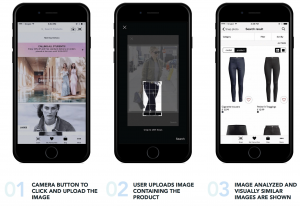Opportunity-
Most large retailers advertise their products to potential consumers through catalogs, sometimes paper-based but increasingly digital. Augmented Reality (AR) technology has the potential to disrupt the $83 bn field of digital advertising [1], and is already starting to do so, especially through product visualization and placement. Product visualization is an extremely important tool for companies which have a large number of products that often cannot be displayed to customers in an efficient format, potentially leading to lost revenue and increased customer churn. AR technology can allow consumers to interact with products much more seamlessly in multiple ways, which include personalized recommendations and more intuitive search mechanisms. In addition, this is an excellent application of augmented imagination techniques since it relies on machines developing the crucial selection step that can allow them to prioritize creative choices based on criteria. [7]
Solution-
ViSenze is a Singapore-based startup founded in 2012 that develops AI for use in visual e-commerce. They have a number of solutions built around the ecosystem of image recognition such as image search, similar product recommendation and automated product tagging. While many companies have enabled image-based search on their websites, ViSenze’s smart algorithms can combine image search with text-based modifications. For example, a user might see a dress that they like but want it as a long-sleeve, and by combining text with visual recognition on the ViSenze platform, they would be able to modify their search criteria. This allows creative solutions from various inputs.
The ViSenze technology stack consists of the consumer clicking images and sending it to the ViSenze API. The API analyzes what is in the image, tags and attributes products and then combines with other contextual, search and internal data to also show visually similar recommendations.
Fig. 1 – Potential Use Case of ViSenze technology[2]
Effectiveness & Commercial Promise-
The potential for a company like ViSenze to achieve profitable performance is significant. Per Statista, in 2017, 1.66 billion people worldwide purchased goods online, and global e-retail sales totaled US$2.3 trillion.[8] . The scale of online shopping and its continued growth, especially into mobile devices, ensures a need for companies to continue to emphasize consumer ease of product search, search result satisfaction, and speedy engagement to drive purchase completion.
Based on the promise that consumers can integrate images into their search, both independently and with text, ViSenze has managed to raise $14M, most recently through Series B funding round [4]. Most of their current customers are focused on the retail space, especially in clothing, jewellery, and interior design, since the feature works especially well in industries with large inventories and somewhat homogeneous products. In an experiment conducted by ViSenze, about 150 tech-savvy people were asked to do a keyword search for a garment they were shown. 96.6% of users were not able to find it; they were frustrated and gave up after 90 seconds. The 3.4% who did find it took 4 – 6 minutes. Visual search managed to beat keywords search by delivering results 9 times quicker than that a keywords search takes. [3]
There are a number of competitors in the space, most focused on either furniture or fashion. Some companies include Slyce and Whodat in addition to image recognition technology from major companies like Amazon and Google. However, while these companies possess similar technological abilities ViSenze is differentiated by focusing on directly adding value to retailers and shopping platforms through offering the function to be tailored to their products. The increased proliferation of companies into the space is based on increased demand for optimized search capabilities by customers.
Alterations-
We see a number of challenges and potential paths ahead for ViSenze:
- Industry specialization: Most B2C startups in this space have focused on fashion and household products. ViSenze could try to specialize in one of the fields that they already have a foothold in, such as jewellery or other luxury products.
- Getting retailers on platform: Larger companies like Amazon and Google already have a wealth of products on their platform and can monetize image recognition tech more easily, for example through more accurate recommendations. ViSenze should use machine learning technology trained on data across parameters both related to the product and the context in order to provide a superior recommendation tool.
- Social media compatibility: Making ViSenze functional on top of social media platforms would be an effective means by which to gather large amounts of data and provide personalized recommendations.
- Allow customers to co-create new designs with the help of AI (search: picture + Long sleeves, or “make it look 80ties”) If the wished product does not exist, and the customer is willing to pay extra, then have an automated factory produce (3d print?) and ship it to you.
- Augmented reality: Let smart mirrors display the new outfit on you based on ViSenze selection.
Sources-
1:http://www.adweek.com/digital/u-s-digital-advertising-will-make-83-billion-this-year-says-emarketer/
2: https://www.visenze.com/visual-search
3: https://www.visenze.com/why-use-visual-search
5: https://www.crunchbase.com/organization/visenze
6: https://www.technavio.com/blog/top-12-image-recognition-software-companies
7: A Big Data Approach to Computational Creativity, IBM Watson Research Center, arXiv (Class reading)
8: https://www.statista.com/statistics/379046/worldwide-retail-e-commerce-sales/
Team Members:
Mohammed Alrabiah
Tuneer De
Mikhail Uvarov
Colin Ambler
Lindsay Hanson

